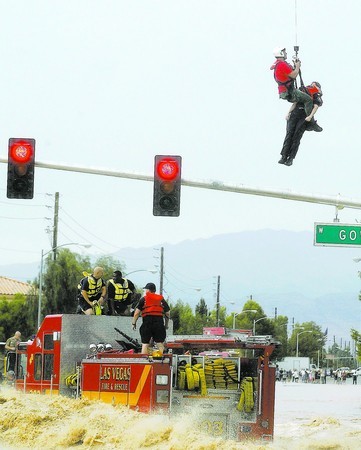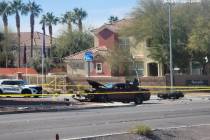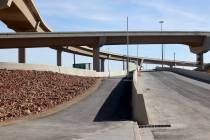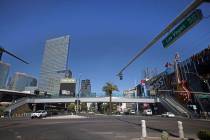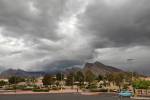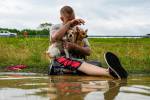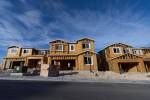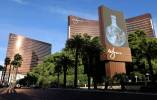Deluge dangers have disappeared
We've had our fair share of rainfall in the Las Vegas Valley this year, but something is missing.
It's just not the same. These storms no longer send media outlets into a euphoric frenzy. News helicopters take to the air and on-board camera operators try really hard to bring you the drama. But really, there is none.
What's the deal? Ah, yes. Allow me to steal the dreaded words my maid muttered when she heard my shower hiss as I rushed to get ready for school in the Philippines: "Walang tubig." English translation: No water.
OK, that's an exaggeration. Of course there is water; in fact we've already been hit with 21/2 inches of rainfall this year, more than half our annual average. But significant rainfall no longer sends a torrent of flood water screaming down our thoroughfares.
Remember the images of a rescue helicopter plucking motorists and firefighters off their vehicles as Gowan Road turned into a raging river in 2003? Or how the Charleston Boulevard underpass became a litter-filled swim quarry? Or the photos of an upside-down Jeep, driver trapped inside, bobbing down Washington Avenue in the early 1990s?
Much to the dismay of drama-seeking news organizations, those days may very well be history.
Tim Sutko, senior hydrologist for the Clark County Regional Flood Control District, said the last time swift-water rescues were necessary was in 2007 after a storm in The Lakes neighborhood in the northwest. A handful of motorists were trapped during that storm as opposed to the 60-plus rescued in 2003.
"We had the intensity and the rainfall (of the 2003 downpour), but nowhere near the problem," Sutko said. "There was some water on the street, but it was nowhere near what happened on Gowan."
The district's work to install those gigantic concrete drainage blocks below roadways will drive motorists nuts. For years, lanes were restricted or totally closed along Oakey Boulevard while the street was torn apart. During those times, it's tough to stop and think about the benefits of the work.
If placed in a straight line, the 550 miles of drainage channels and washes that snake about the valley could reach the San Francisco Bay Area. The district plans to build another 250 miles of channels.
These drainage systems haven't done squat, you say. Drive anywhere in town during a storm and you'll find lanes along the sidewalk buried in several inches of water, right? Probably. But the streets are crowned for that reason. Drivers might need to squeeze into one lane, but at least the road won't be completely closed to you and emergency vehicles.
"When we're done, there will still be water in the street," said Kevin Eubanks, assistant general manager of the Flood Control District. "If we reduce it to a nuisance or even a severe nuisance, it's a success. A firetruck is not going to get washed around. We may get knocked down, but we'll get back up."
Charleston no longer floods and the reason for that starts up near Red Rock Canyon. The Red Rock basin combined with improved flood channels collects water rushing off the mountains and guides it through the Las Vegas Valley, ultimately delivering it to Lake Mead.
The Gowan-Rainbow Boulevard problem was alleviated when channels leading to and from the Gowan basin were built. They were in the design phase when the flood struck. At that time, water had one place to rush and that was Gowan, the only underpass leading to the raised Highway 95.
On top of that, the basin was pouring out 10,000 cubic feet of water per second; now it spits out 3,000 cubic feet during a severe storm.
"At the time, we had three detention basins but we didn't have a channel system to get the water into the basin," Sutko said. "The solution to the problem, the collection system, was in the works."
An underground drainage system also was installed on Colorado and Washington avenues, both historic trouble spots. Boulder Highway and surrounding streets have been spared flooding since nearby washes were blanketed with concrete, efficiently moving water through the area.
"We get a bad rap for the concrete because it's not pretty, but we don't have much of a choice in urbanized areas," Eubanks said.
Other areas still pose problems, but to a lesser degree. For example, during a storm you'll catch most news crews at the intersection of Winnick Avenue and Audrie Street behind the Imperial Palace. The Imperial Palace valet parking garage has long been treacherous during heavy rainfalls.
The problem is that the district could not install an underground drainage system without the threat of weakening the footings of the hotel-casino.
It's taken years for the district to identify the problem areas and find the funding to fix them. Based on the recent rains, flood control representatives believe their efforts have been successful.
"Our goal is to keep people from getting killed and prevent property damage," Eubanks said. "It takes awhile to do the work in the roads, but we think the inconvenience is worth it."
If you have a question, tip or tirade, call Adrienne Packer at 702-387-2904, or send an e-mail to roadwarrior@reviewjournal .com. Please include your phone number.
Ackerman Avenue will be closed between Durango Drive and El Capitan Way until Feb. 22 as the storm drain is repaired.
• Main Street between Las Vegas Boulevard and Owens Avenue in North Las Vegas will be closed until the end of the month.• Watch for lane restrictions on Durango Drive between Cheyenne Avenue and Alexander Road as the city repairs the asphalt. The restrictions will be in effect on weekdays for the next five months. Lane restrictions will also be in place on Alexander between Cimarron Road and U.S. Highway 95.
• Lane restrictions are in place on Village Center Circle, on Hills Center Drive between Village Center and Lake Mead Boulevard, and on Town Center Drive between Village Center and Summerlin Parkway. Traffic restrictions with sidewalk closures could be in effect around the clock on weekdays.
• Expect lane closures and shifting on Craig Road for the next eight weeks as North Las Vegas starts converting the Craig Ranch Golf Course into a regional park.
• Work has begun on Neon Boneyard Park. During construction hours, which are between 7 a.m. and 3 p.m., expect road closures on parts of McWilliams Avenue, Ninth Street and Encanto Drive.
• Construction continues on Flamingo Road between Interstate 15 and Audrie Street. Flamingo is reduced to one lane at the intersection of Las Vegas Boulevard. On Tuesday, crews will be pulling cable at Flamingo and Via Del Nord east to Audrie. Major delays are expected along Flamingo.
Las Vegas Review-Journal



